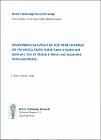| dc.contributor.author | Herr, Claudia | |
| dc.contributor.author | Gray, Nicholas Frederick | |
| dc.date.accessioned | 2017-06-08T09:30:46Z | |
| dc.date.available | 2017-06-08T09:30:46Z | |
| dc.date.issued | 2017-06-08 | |
| dc.identifier.citation | Claudia Herr, Nicholas Frederick Gray, 'ENVIRONMENTAL IMPACT OF ACID MINE DRAINAGE ON THE AVOCA RIVER: Metal Fluxes in Water and Sediment. Part III. Metals in Water and Suspended Particulate Matter.', [report], Tigroney Press, 2017-06-08, Technical Report (Water Technology Research), 21, 1, 1995-04-01 (reissued 2017-06-08) | en |
| dc.identifier.isbn | 9781912290109 | |
| dc.description.abstract | Water and suspended particulate matter (SPM) was collected at weekly intervals during low flow conditions from the Avoca River (May and August, 1994). The total concentration of Zn, Cu, Cd and Fe was measured in both the dissolved and particulate phase. To model metal fluxes, flow measurements of the river and the main leachate streams were also taken. It was shown that the acid mine drainage (AMD) discharged into the Avoca River from the two leachate streams (the Deep and Ballymurtagh Adits) decreased concurrently with a decreasing river flow. Concentrations of dissolved Zn, Cu and Fe generally decreased downstream from the AMD input showing maximum metal concentrations at the site closest to the AMD discharge points. No Cd was detected <0.001 mg/l) in either the water or particulate mater in river samples. Zinc adsorption onto suspended particulate matter is clearly influenced by pH, with concentrations of Fe and Cu higher in the particulate phase compared to the dissolved phase, suggesting that the main transport mechanism of metals
is through association with the particulate phase. Temporal fluctuation showed that metal concentrations, particularly Fe and Zn, are strongly effected by hydrological factors in the river and leachate streams. Metal fluxes were shown to differ substantially under various flow regimes, with Zn not removed from the dissolved phase during low river flow. Using sulphate as a conservative ion enables quantitative predictions to be made with regard to percentage metal contribution from the main adits. A significant relationship between percentage contribution of sulphate and the ratio of river/ AMD discharge was apparent. | en |
| dc.language.iso | en | en |
| dc.publisher | Tigroney Press | en |
| dc.relation.isversionof | ISBN (print version) 1872220223 | |
| dc.rights | Y | en |
| dc.subject | River sediment | en |
| dc.subject | River Avoca | en |
| dc.subject | River water quality | en |
| dc.subject | Acid mine drainage | en |
| dc.subject | Avoca mines | en |
| dc.subject | Avonmore Catchment | en |
| dc.subject | Water pollution | en |
| dc.subject | Water quality assessment | en |
| dc.title | ENVIRONMENTAL IMPACT OF ACID MINE DRAINAGE ON THE AVOCA RIVER: Metal Fluxes in Water and Sediment. Part III. Metals in Water and Suspended Particulate Matter. | en |
| dc.type | report | en |
| dc.contributor.sponsor | European Union | en |
| dc.type.supercollection | edepositireland | |
| dc.publisher.place | ireland | en |
| dc.description.version | 1st edition (reissued) | en |
| dc.relation.ecprojectid | info:eu-repo/grantAgreement/EC/FP7/EV5V-CT93-0248 | |
| dc.rights.ecaccessrights | openAccess | |
| dc.contributor.sponsorGrantNumber | EV5V-CT93-0248 | en |
| dc.relation.ispartofseriesdate | 1995-04-01 (reissued 2017-06-08) | en |
| dc.relation.ispartofseriesissue | 1 | en |
| dc.relation.ispartofseriestitle | Technical Report (Water Technology Research) | en |
| dc.relation.ispartofseriesvolume | 21 | en |
| dc.rights.holder | Water Technology Research | en |
| dc.description.note | First Published in print format April 1995. Reissued in pdf format June 2017 | |
| dc.identifier.uri | http://hdl.handle.net/2262/80360 | |




